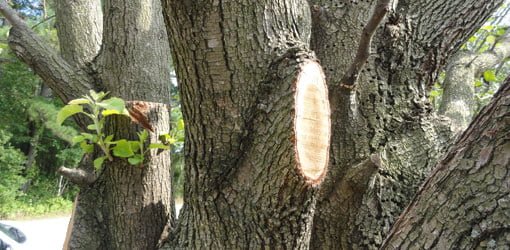How to Deal with Broken Branches on a Bradford Pear Tree

A large limb has ripped off my Bradford pear tree, leaving a huge gash in the trunk. What should I do? -Carmen
Bradford pear trees are common in many neighborhoods, known for their beautiful spring blossoms and rapid growth. However, these trees are notorious for their weak branch structure, which often leads to broken limbs and split trunks. When faced with damaged branches on a Bradford pear, you need to know how to properly assess and address the situation. In this guide, we explain how to deal with broken branches, prevent future damage, and ultimately decide whether to save or remove the tree.

Understanding Bradford Pear Trees and Their Vulnerabilities
Bradford pear trees (Pyrus calleryana) were once a popular landscaping choice due to their attractive appearance and fast growth. However, their structural weaknesses have become increasingly apparent over time. These trees typically grow to 30-50 feet tall with a spread of 20-30 feet, often developing a rounded or oval crown.
Why Bradford Pears Are Prone to Breaking
Several characteristics make Bradford pears susceptible to breakage. Specifically, their branches often grow at tight angles to the trunk, creating weak attachment points. Bradford pears also have a dense canopy with thick foliage that can catch wind like a sail and increase stress on branches. Bradford pears also grow quickly, and their rapid growth can lead to weaker wood and an unstable structure.
These factors make Bradford pears particularly vulnerable during storms, high winds, or under the weight of ice and snow. Understanding these vulnerabilities can help you maintain your tree’s health and stability.
Assessing Damage to a Bradford Pear Tree
When a Bradford pear suffers broken branches or trunk damage, assess the extent of the injury to determine the best course of action.
Evaluating the Extent of Damage
To determine the damage extent and severity, examine the size of the broken limb in relation to the trunk. Smaller branches are less of a concern compared to larger, structural limbs. Then, check for any splits or cracks extending into the main trunk, as these can compromise the entire tree’s stability. Finally, assess how the breakage affects the tree’s canopy. A tree with significant canopy loss may struggle to recover.
If more than 50% of the tree’s structure is damaged, or if the trunk shows significant damage, you may need to remove the tree altogether. For less severe damage, you could recover the tree with appropriate pruning and care.
Immediate Actions for Broken Branches
When dealing with freshly broken branches on a Bradford pear, prompt action can help prevent further damage and promote healing.
Removing Broken Limbs Safely
To safely remove broken limbs from your Bradford pear, use clean, sharp pruning tools appropriate for the branch size. Cut outside the branch collar, and avoid cutting flush with the trunk. As you cut, support larger branches so the bark does not tear.
Cleaning Up the Wound
After removing broken branches, trim any ragged edges of bark around the wound to prevent further tearing. Remove any loose or damaged bark to create a clean edge and facilitate proper healing. Leave the area open to air to allow natural callus formation, which is crucial for the tree’s recovery. Avoid using wound dressings or tree paint, which may interfere with the tree’s natural healing process.
Long-Term Care for Damaged Bradford Pears
Proper care following damage can help your Bradford pear recover and potentially extend its lifespan.
Promoting Healing and Recovery
To support a damaged Bradford pear, provide adequate water, especially during dry periods. Sufficient moisture is vital for recovery. Apply a balanced fertilizer in the spring to support new growth and replenish nutrients lost through injury. As your tree heals, monitor it for signs of stress or disease, such as wilting leaves.
Monitoring for Signs of Decay
Watch for signs that your Bradford pear is not healing. These may include:
- Fungal growth around the wound or on other parts of the tree could indicate infection.
- Discoloration or softening of the wood near the injury site may signal internal decay.
- Continued dieback of branches in the canopy is a potential sign of irreparable damage.
If you notice these symptoms appear, consult with a certified arborist to determine if you should remove the tree.
Pruning Techniques to Prevent Future Breakage
Proper pruning helps maintain your tree’s health and structural integrity while preventing future breakage.
Establishing a Strong Structure
When pruning Bradford pears remove suckers and water sprouts that grow vertically along branches or from the base, as they divert energy from the main structure. Thin out branches that are too close together or rubbing against each other, reducing the risk of breakage. Prune strategically to establish a strong central leader and well-spaced lateral branches for a balanced canopy.
Timing and Frequency of Pruning
Bradford pears should be pruned when they are young to establish proper structure before weak branches develop. Try to prune them during dormancy in late winter or early spring before new growth begins. Avoid heavy pruning in late summer or fall, as this can encourage new growth that may not harden off before winter. However, you should also prune dead, diseased, or damaged branches as needed to maintain your tree’s health.
When to Consider Tree Removal
Sometimes, despite your best efforts, removing Bradford pear becomes the safest and most practical option.
Signs That Indicate Removal Is Necessary
Consider removing your tree if:
- The tree has split down the middle of the trunk, compromising its structural integrity.
- More than 50% of the major limbs are damaged, reducing the tree’s ability to recover.
- The tree shows signs of extensive internal decay through fungal growth or hollow areas.
- The tree poses a safety hazard to structures or people, especially in high-traffic areas.
Hiring a Professional for Tree Removal
Tree removal requires specialized equipment and knowledge, so you benefit from using a professional tree removal service or arborist. When seeking tree removal services, obtain quotes from several certified arborists or tree removal services to secure a competitive price. During your consultation with potential servicers, clarify every step of the removal process, including stump grinding and wood removal. Before you sign a contract, verify that the company is properly insured and certified to avoid liability issues.
Alternatives to Bradford Pear Trees
For those considering replacing a Bradford pear or planting a new tree, there are several more stable alternatives. Choosing the right replacement can enhance the landscape without the vulnerabilities associated with Bradford pears.
Recommended Tree Species for Replacement
The following plants offer suitable replacements for a Bradford pear tree:
- Flowering dogwood (Cornus florida): Known for its stunning blooms and graceful appearance.
- Eastern redbud (Cercis canadensis): Offers vibrant spring foliage and a striking form.
- Serviceberry (Amelanchier spp.): Provides beautiful flowers and edible fruit, along with robust structural integrity.
These trees offer similar aesthetic benefits without the structural weaknesses of Bradford pears.
Final Thoughts About Dealing with Broken Branches on Bradford Pear Trees
To deal with broken branches on Bradford pear trees, you must focus on both immediate solutions and long-term care. While these trees can present challenges due to their weak structure, proper pruning and maintenance can help mitigate some risks. However, homeowners should be prepared for the possibility of removal, especially as the tree ages or sustains significant damage.
When faced with a damaged Bradford pear, assess the situation carefully and consider the tree’s health and the safety of the surrounding area. By understanding the unique characteristics of these trees and implementing appropriate care strategies, you can make informed decisions about managing your Bradford pears tree, whether that means preserving it or choosing a more suitable alternative.







Leave a Reply